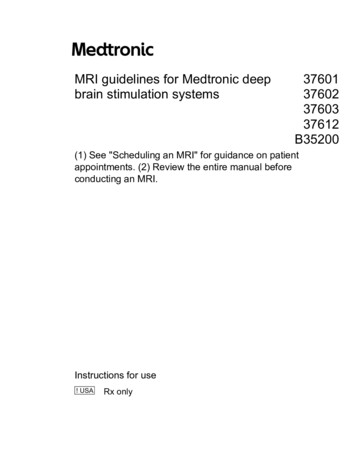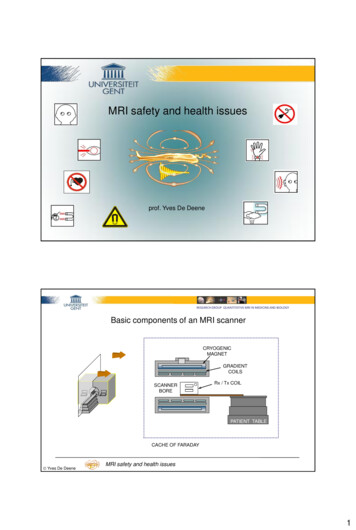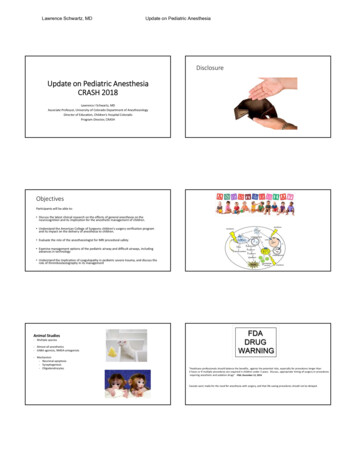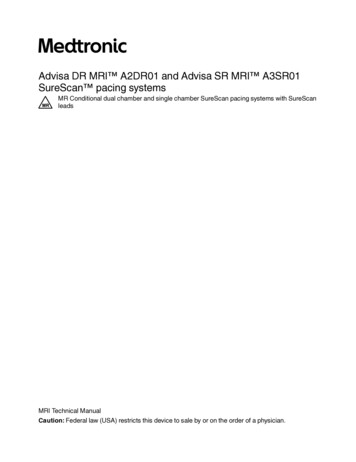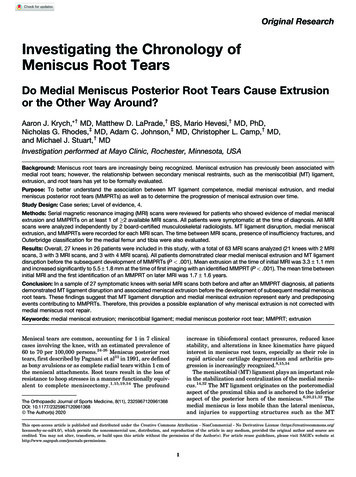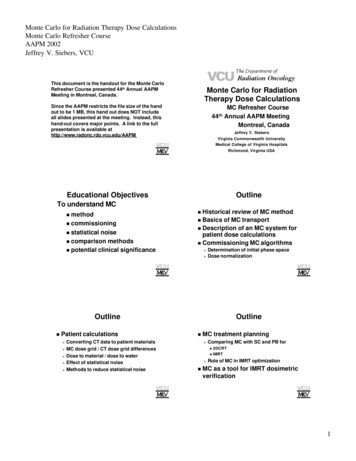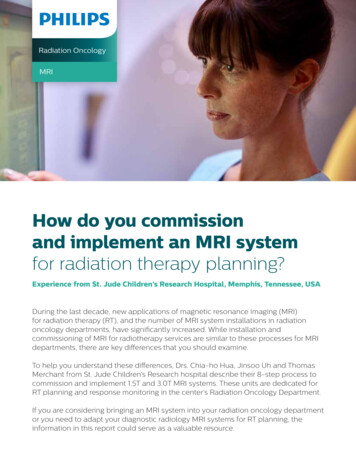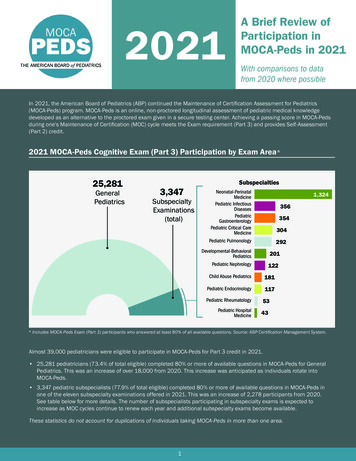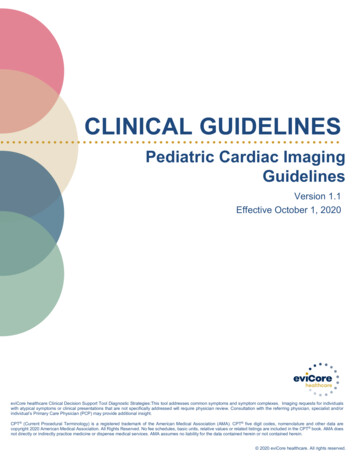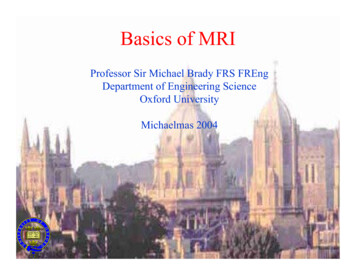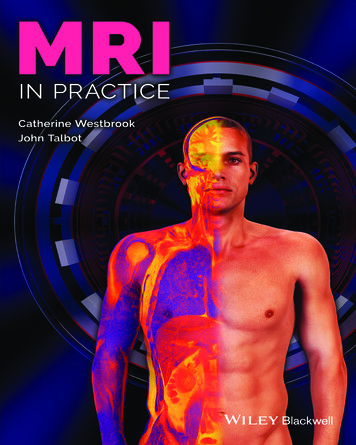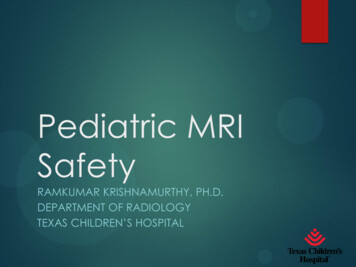
Transcription
Pediatric MRISafetyRAMKUMAR KRISHNAMURTHY, PH.D.DEPARTMENT OF RADIOLOGYTEXAS CHILDREN’S HOSPITAL
Disclosure Contrast agents not FDA approved in PediatricPopulation
Learning Objectives MRI Safety in adults and pediatrics Recent advances in knowledge about pediatricMR safety Safe MR Practices to adopt in a pediatricpopulation
MR Imaging Life Saver Huge advances over lastdecade Ionization Radiation free Considered safe forrepeat studies 10% annual growth ofpediatric MRI (and all MRI)over last decade
MR Safety MR Safety aspects sometimes ignored Critical in pediatric patients If gone wrong, would be a catastrophe Pediatric specific guidelines not easily available
ImplantsRFHeatingProjectileMRISafetyContrastPNS
Safety RequirementsPediatric MRI SafetyChildrenPre-schoolInfants6-12 yearsAdolescents13-18 years2-5 years 2 yearsNeonatesImage Courtesy: https://www.pinterest.com/pin/98375573084559254/
ion10% sedation rate inpediatricsContrastPNS
Pediatric MRI Safety:ACR Recommendations
ACR recommendations:Sedation Essential for good image quality Continuum of sedation1 Mild, moderate, deep sedation MRI scan times are unpredictable Anesthesia used for longer scans Sedation increased hospital stay 1.5 hours1. Schulte-Uentrop et al. Curr Opin Anesthesiology 2010, 23:513–517
Sedation: AnesthesiologistIssues1.2.3. Thermal regulation issues, especially in neonates –hypothermia1 Evidence of neurotoxicity, learning diasbility withrepeated anesthesia2,3 Deeper sedation than intended4 Reaction to a code in zone III/ IV4Young et al., Eur J Anaesthesiol 1996;13:400–3Bong et al. Ped. Neuroscience, Volume 117 Number 6Yu et al., F1000Research 2013, 2:166
Sedation: MRI PersonnelIssues Monitoring devices Adverse reaction to sedation/ code Ventilator, anesthetic gasmeasurement, pulse oximetry, ECGmonitor, blood pressure measurementand respiratory frequency monitorDisabled children responseNo feedback from patient
Sedation: Safe Practicesto Follow Vigilance during screening Incident at Texas Childrens No accompanying personnel if sedated Try and reduce sedation ‘Feed and Bundle’ in neonates, infants1,2 Child Life Support (15% reduction in 5-10 yeargroup)3 Movie with eyeglasses1. Shariat et al., Pediatr Cardiol (2015) 36:809–8122.Neubauer et al., Acta Paediatrica 100:1544–15473. Durand et l., J Am Coll Radiol 2015;12:594-598Img courtesy: Az med center
ACR recommendations:Screening Proper, comprehensive screening essential for pediatric population Implants, MR unsafe materials on patients, accompanying personnel, sedation monitoringdevices Double screen Once privately for teenage patients (tattoos, piercings) Scanning Technologist final one to sign off Gown all patients compulsorily
Screening Educate all MR personnel –level I and level II Implement zoning Have a continuouseducation policy, at leastonce a year Once patient in zone IV,scanning technologist hasfinal say Effective communicationessential
ACR Recommendations:Accompanying family Accompanying family more common in pediatricpopulation Implement one person only rule Safety screening for the accompanying adult TCH incidentRestrict entry for sedated kids
Implementation of ACRGuidelines: MRI Safety Committee Effective way to implement ACR guidelines Effective feedback mechanismCommittee comprises of: MRI Safety Officer, RSO, leadtechnologist/Manager, anesthesiologist, nurse,radiologist, department leader Empowered to design policy for MRI safety Meet quarterly Designate a MRI Safety Officer Technologist, RSO, MRI physicist, MRI manager,Radiologist Researching implants, zoning
MRI Safety Committee Discuss any recent incidences, near misses Safety related workflow and image quality issues Design and implement hospital specific newpolicies @ TCH, Implant policy for smooth workflow Screening sticker policy Contrast adverse reaction policy No family accompanying sedated patients Switch to macrocyclic contrast agents
ion10% sedation rate inpediatricsContrastPNS
MRI Powerful magnets – 1.5 – 3T 1T 10,000 Gauss Earth’s magnetic field: 0.5 Gauss Modern magnets actively shielded Fringe field extent is small (5 G) Spatial gradient is huge (Projectile, torque) RF used for excitation : 64/128 MHz (SAR/ RF burns) Fast switching gradients (dB/dt, PNS) Gd based exogenous contrast agents
Projectile6 year old – Pediatric Patient
Potential Projectiles examples
Pediatric MRI Safety:Projectiles Ferromagnetic implants, other monitoring devices Alloys containing iron, nickel, cobalt Compulsory gowning for pediatric patients Screen sedated patients carefully Recent incident at Texas Children’s If unsure, do your research, ask vendor Minimize devices in MRI scanner room
Pediatric MRI Safety:Implants Implant decision making nerve wracking Especially in sedated kids Rigorous screening essentialNo implant is MR Safe MRI conditional, MRI unsafePediatric patients come with wide array ofimplants Inclusive of most adult implants Shunts, DBS etc. Also, tattoos, piercings etc.Image Courtesy: ffect-tattoos.html
Pediatric MRI Safety:Implants Screen for prior MRI of patients Have X-ray policy readyEstablish good communication between variousdepartments Surgery Have list of prior encountered implants Have contact number/name for common implantmanufacturers ready Have them send out a MR safety letter aboutimplants. Document any newly encountered implants
Implants DecisionMaking Hierarchy Pre screen the patients If technologist cannot determine safety,escalate to lead tech/ Safety officer If still undecided, communicate withmedical director/ ordering Radiologist Risk to Benefit ratio
Pediatric MRI Safety:RF Heating RF – non-ionizing radiation RF heating and burns are frequent Burns most common cause of MR safetyrelated incidents1 SAR – heat deposition by RF (local,global) Heating burns in leads, implants Heating burns – body as a loopFDA regulations1. FDA MAUDEImg crtsy: FDA
Pediatric MRI Safety:RF Heating Critical to input the right weight of patient Proper positioning, insulation using pads Check for MRI compatible leads Re-emphasis through-out the scan
Pediatric MRI Safety:Contrast Gadolinium based contrast agents widelyused Reduction in T1 Highlights tumors, abnormal vasculature,perfusion deficitsDifferent types Linear non-ionic (OmniscanTM, OptimarkTM) Linear ionic (MagnevistTM, MultihanceTM,AblavarTM) Macrocyclic (DotaremTM, GadovistTM,ProhanceTM)
Pediatric MRI Safety:Contrast Nephrogenic Systemic Fibrosis MR Safety issues: Contrast adverse reaction1 Nausea, vomiting, more serious adverse events Allergies more common in children (FDA guidance) Accumulation of Gadolinium in body2Accumulation of contrast in body Switch to macro-cyclic contrast agents3 @ TCH, efforts on to move to macro-cyclic agents1. Hao et al Jn OF MRI36:1060–1071 (2012)2. Morris et al., AJNR Am J Neuroradiol. 2007 Nov-Dec;28(10):1964-73. Balassy et al., Pediatr Radiol DOI 10.1007/s00247-015-3394-9
Other Pediatric MRI SafetyIssues Peripheral Nerve Simulation Acoustic Noise 99 dB 3T 1.5 T Genotoxic effects of MRI1 Effect on pre-term babies Fetus imaging1. Simi et al., Mutation Research 645 (2008) 39–43
The Most CommonlyEncountered MRI SafetyIssue is 2%1.2%2.81%3.12%4.3%5.Acoustic InjuriesSevere Contrast ReactionRF Heating BurnsMissile EffectImplant Disturbance
The Most CommonlyEncountered MRI Safety Issue RF Heating Burns [Reference: MAUDE] Tattoos Implants – could be 100 different things Wires and Leads (Most common) Piercings/ Jewelry Patient crossing legs/ hands Different from tissue temperature increase due toRF energy deposition
It is critical to provide the MRtechnologist with the infant'sactual body weight to0%1.81% 2.0%3.19% 4.0%5.Manage MRI scanner table vibrationsAvoid excessive RF exposureDetermine safety of an implanted objectDetermine sedation time/limitationsSet fastest possible imaging protocol
It is critical to provide the MRtechnologist with the infant'sactual body weight to Avoid excessive RF exposure
Pediatric MRI: ImageQuality Considerations Think in tandem with safety / artifacts Extreme size variations Various implants/needs Appropriate coil selectionImaging with ArtifactsTailor sequences for Varying sizes Varying restrictions based on MRI conditional implants Patient motion for non-compliant kids
To Conclude MRI is a life saver Thing life long burden in pediatric patient Contrast, sedation, MRIs Enable reduction of sedation Implants Safety and Screening Think RF heating and burns MRI Safety CommitteeMRI is a life saverhttp://www.lifewithelizagrace.com/2009 07 01 archive.html
Acknowledgements Frank Goerner, Ph.D. – RSO, Texas Children’sHospital Anne Sawyer, RT – FDA ents/WorkshopsConferences/UCM283562.pdfRadiology department colleagues at TCH
Thank You!
References ACR Safety Document (JMRI 2013) Small Pediatric ReferenceEnsuring Safety for Infants Undergoing MagneticResonance Imaging Laura A. Stokowski, RN, MS. Adv Neonatal Care.2005;5(1):14-27. http://www.medscape.com/viewarticle/499273
Sedation: Safe Practices to Follow Vigilance during screening Incident at Texas Childrens No accompanying personnel if sedated Try and reduce sedation 'Feed and Bundle' in neonates, infants1,2 Child Life Support (15% reduction in 5-10 year group)3 Movie with eyeglasses 1. Shariat et al., Pediatr Cardiol (2015) 36:809-812 2.Neubauer et al., Acta Paediatrica 100:1544-1547
